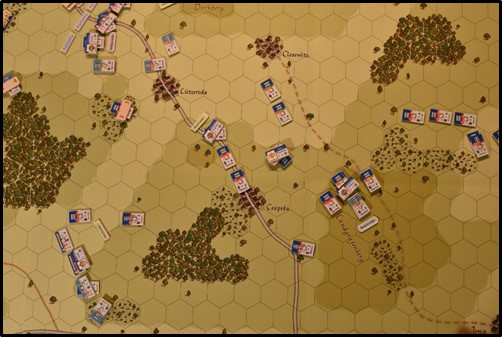6:30 French turn
The thick fog persisted. Soult arrived along the road from Gera. Arriving reinforcements are provided with a march order, here is what Napoleon instructed Soult to do:
Soult’s orders:
-
Primary order: Tactic: march. Objective: move to a position between the woods west of Cospeda and the woods east of Isserstedt. Conditions: move via Cospeda.
-
Secondary order, if primary order succeeds: Tactic: Defense. Objective: set up a defensive line with the cavalry in the south covering, but not on, the Weimar-Jena road. Conditions: none
-
Secondary order, if primary fails: Tactic: defense. Objective: establish defensive line as close to above position as possible. Conditions: none.
Soult followed the order and gained a fatigue.
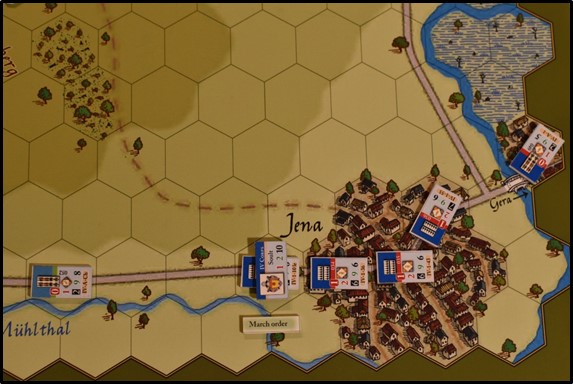
Soult’s arrival.
Lannes was still under his attack order from Napoleon, and so maintained his attack. The placement of the Prussian cavalry behind Lutzeroda was troubling Lannes, although the fog restricted charge range to some 500m (2 hexes), French infantry would be within that if they closed on the village from the east. After some deliberation, the 88th Line Infantry swung around to the west of Lutzeroda to avoid the Prussian light cavalry, they took some opportunity fire from the village but it had negligible effect. The 17th Light Infantry also moved up to the village and were joined by Lannes who wanted to make sure the attack went as he had instructed. The 103rd infantry restrained their advance not wanting to provide an easy target for the Prussian horse, although it did send out its voltigeurs to add some firepower to the attack on the village.
In order to change flanks, the French cavalry swept across in front of the main French line and formed up some 500m from the Prussian cavalry – both sides peered at each other through the still dense fog, both just out of effective charge range of each other. In the centre and right, the 21st Light Infantry vacated Closewitz and advanced to within 250m of the Prussian line, they deployed their voltigeurs to which Prussians line infantry in 1806 had no response. Only the Prussian light infantry, on the road north of Lutzeroda, could counter them with their own skirmishers.
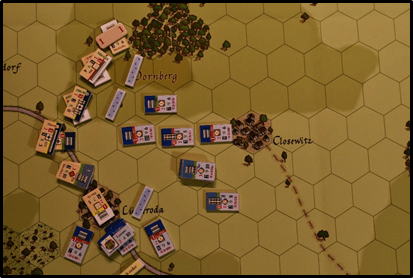
The position after French movement – the Prussian and Saxon line infantry cannot deploy skirmishers in 1806, a fact the French quickly exploited.
Prussian infantry fire from Lutzeroda was ineffective and so was the return fire from the French artillery and skirmishers. Formed lines of infantry are ineffective against dispersed skirmishers (cannot target them) but Prussian artillery caused casualties within the French 34th Infantry and it fell back disorganised after their first taste of Prussian iron (despite having a morale of 9, a 10 was rolled). The retreating 34th were just visible to the Prussian light cavalry (optional rules allow light cavalry to counter-charge from 2 hexes – which was also the maximum charge distance in the thick fog). The Prussian chasseurs could not organise themselves in time to charge, but the hussars did. They charged into the sizeable French unit, the 34th was routed and took an additional loss as they fled from the cavalry, (gaining a +1 DR for being light cavalry against disorganized units. It was a 1:1 attack in which they rolled a 6 +1).
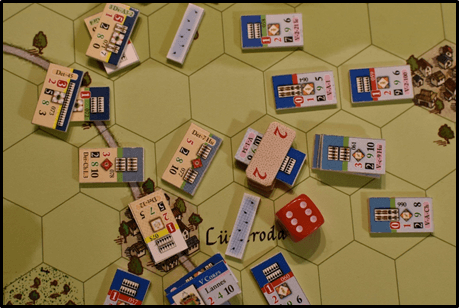
The moment of impact… (note the French voltigeurs east of Lutzeroda should have been removed when the Prussian cavalry moved adjacent).
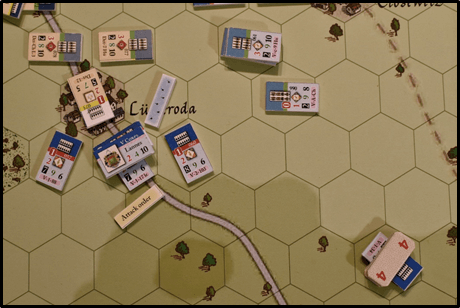
The routing 34th can be seen in the lower right of the picture
Lannes undeterred, by the fleeing 34rd Infantry, launched his assault on Lutzeroda. Again, his leadership (+2 combat modifier) proved crucial and the Saxons were driven from the village. Furthermore, in fleeing they passed through the chasseurs, which in turn caused them to lose cohesion, become disorganized and retreat. Lannes and the 17th Light Infantry occupied the village.
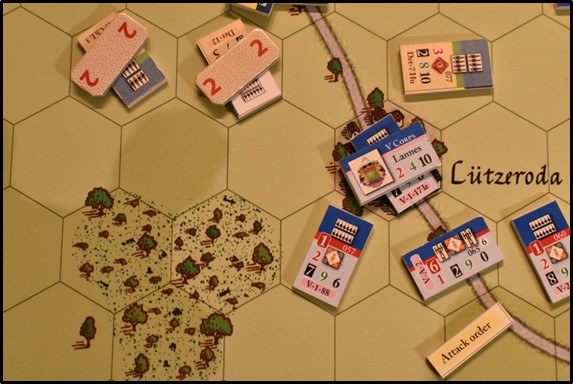
The Saxons retreating from Lutzeroda became intermingled with the chasseurs which in turn forced them to become disordered.
As the clock approached 6:30 am, the 17th Light Infantry deployed voltigeurs to cover the disorganized Saxons just expelled from the village.
Lannes’ Corps accumulated another 2 fatigue, putting them onto a total of 4.
6:30 Prussian turn
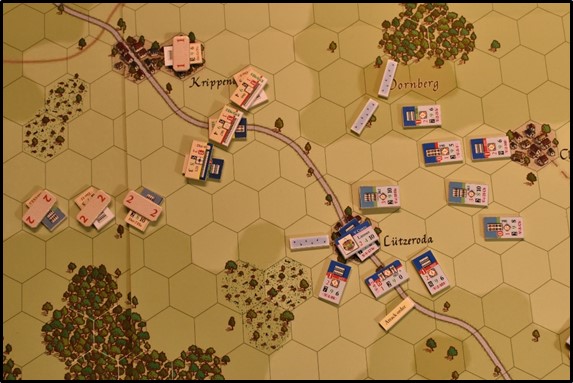 The routing of the 34th Infantry was something for the Prussian and Saxons to celebrate but the disorganisation of the chasseurs was a serious reverse as the French already outnumbered the Prussian horse. The Prussians continued to fall back to try and preserve a cohesive battle line. The Prussian 7th Hussars now found themselves exposed and in trying to beat a retreat the French 9th & 10th Hussars charged them. The Prussian horse fell back disorganised but sustained very few actual casualties.
The routing of the 34th Infantry was something for the Prussian and Saxons to celebrate but the disorganisation of the chasseurs was a serious reverse as the French already outnumbered the Prussian horse. The Prussians continued to fall back to try and preserve a cohesive battle line. The Prussian 7th Hussars now found themselves exposed and in trying to beat a retreat the French 9th & 10th Hussars charged them. The Prussian horse fell back disorganised but sustained very few actual casualties.
The Prussians fall back again… The Prussian detachment gained another fatigue, putting them on a total of 2.
